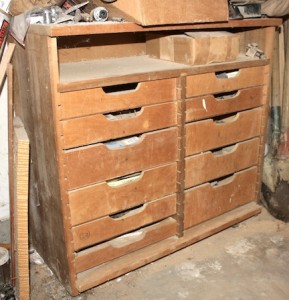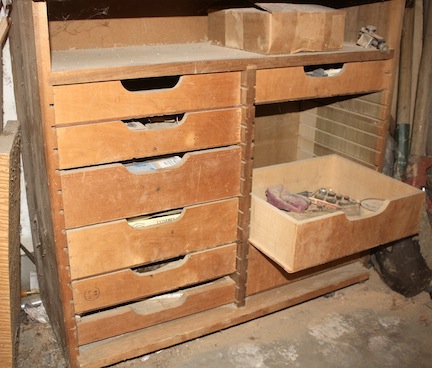We may receive a commission when you use our affiliate links. However, this does not impact our recommendations.
 As I read many of your comments and suggestions for my bench drawer storage, I also talked with executive editor Bob Lang. Bob suggested that I consider making my drawers depths in multiples of 2″, such as 2″, 4″ and 6″ deep drawers. If I then position the grooves cut into the case sides at 2″ apart, I could constantly rearrange the drawers until I found the best layout.
As I read many of your comments and suggestions for my bench drawer storage, I also talked with executive editor Bob Lang. Bob suggested that I consider making my drawers depths in multiples of 2″, such as 2″, 4″ and 6″ deep drawers. If I then position the grooves cut into the case sides at 2″ apart, I could constantly rearrange the drawers until I found the best layout.
If you look at the photo to the left, which is the cabinet my Dad made early on in his woodworking days, you see that’s exactly how the cabinet is arranged. (Also see the photo below.)
This idea has been put into my design however, a 6″-deep drawer is too deep in my opinion. The deepest drawer in my current workbench is 6-1/4″, and I find that I use those drawers for storage of less-than-necessary woodworking items – if there is such a thing.
All things considered, I think I’ll build two 4″ drawers and eight 2″ drawers to fill the two stacks.
If you’re searching for more drawer information, check out these selections:
Bill Hylton wrote “The Drawer Book” (PDF) – A Comprehensive Guide for Woodworkers or Rob Cosman’s DVD “Drawer Making The Professional Approach.”
Here are some supplies and tools we find essential in our everyday work around the shop. We may receive a commission from sales referred by our links; however, we have carefully selected these products for their usefulness and quality.










I’m planning a similar tool cabinet and want to use this drawer design, however I’d like some possible alternatives to solid wood for the cabinet sides. What else would hold ‘a groove every 2 inches’ in which the drawer bottoms slide – 3/4, 7/8, or 1″ Baltic birch? Something better? Thanks for any suggestions
Doug
Glen, I just built a bank of eight upper and lower cabinets along one wall of my shop. In four of the lower cabinets I built two slide out shelves in each of the cabinets. (I’m getting to the part which relates to your workbench). In the remaining four lower cabinets I built eight drawers. All of the drawers are on full extension ball bearing slides. Each cabinet contains three 2″ drawers, three 3 1/2″ drawers, and two 6 1/4″ drawers. This configuration works very well for me, although I favor the smaller drawers. Since the cabinets are Euro style they have pre-drilled holes which enables me to easily rearrange the drawers or to even change their sizes. I intuitively selected these drawer sizes and was pleased that they were very similar to what you are using. If I were to do it again I would probably use your 2, 4, 6 system. However, I’m not going to add drawers to my Roubo workbench. I’m afraid that I agree with Chris Schwarz on this. On the other hand I prefer the style of furniture which you build. I would like to see more of your style in “Popular Woodworking”.
I seem to remember Tage Frid (early contributor to FineWoodworking) doing something quite similar to this. 10 years ago, I make my touch up kit with drawers just like this, except 1″ increment tall drawers, 5 high, 3 wide with a shelf underneath in a tote. It’s easy to pull out a drawer and take it to the work.
Why is it that the simplest ideas seem to be the most brilliant. I am currently in the process of redoing some of my shop and the 2″ idea just made a lot of things much easier. WELL DONE!!!
I couldn’t help but comment on the similarity of your drawers to the ones I made some years ago from ‘tote boxes’ reclaimed from a school demolition project. The original tote boxes are fir, and are smaller than your drawers (14″ wide x 16″ deep x 5-1/2″ high) with ‘handle’ cutouts almost identical to yours. The depth worked well with a wall workbench I built, and in each of 5 drawer banks I used three totes in their original size, and reduced the height to 4″ in the top two. Even though these tote boxes are well over 50 years old, and were assembled with simple half-lap joints, nails and hide glue, none have come apart thus far, even with heavy-duty shop use.
Great idea! Thanks Glen (and Bob).
It appears that the bottoms of the drawers are hardboard and double as the drawer slides in the rabbits. I haven’t tried this method yet as I was concerned about the life of the hardboard and rabbit. How does this method hold up to wear of opening and closing the drawers? Also, when a drawer is “full”, how easy/difficult is it to open and close the drawer?
Thanks for sharing. I love the simplicity and the “standard” spacing of the rabbits.
Michael
I have a deep drawer at the bottom of my stack which I use to stand up bottles of glue. I have a collection of 1 litre squeeze bottles for Titebond I, II and III, and also the containers for the epoxy. I find it very useful to be able to stand these guys up.
pete
Good post Glenn, I like the way you have turned your workbench project into a series of posts. Also like Bob’s idea regarding drawer heights and option for shuffling the drawers around.
http://www.woodworkingwithajo.com